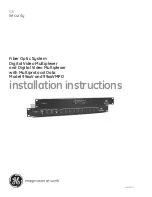
4.4.1 Triggering the SMX2040 DMMs
The SMX2040, SMX2042, and SMX2044 can be triggered to measure selected Scanner channels. The
interface requires a single jumper between the SMX4033/30
TrigComm
and
Common
lines, and two
interface wires connected to the SMX2040 series Trigger input. Once connected, the Scanner can be setup
to produce a trigger signal for each relay selection operation. The various auto scanning operations can
run independently from the computer, whereby the Scanner selects a list of channels stored in its Scan
List table, and the DMM is triggered to take measurements following each channel selection.
Figure 4-12. Trigger interfacing connection to an SMX2040 PXI DMMs.
4.4.2 Multiplexing with the SMX2040 DMMs
For two wire measurements, the SMX204X DMMs must be connected to the A-Bus of the scanner, or to both, the
A-Bus and C-Bus for 4-Wire measurements. It is important to consider system-settling time when making
measurements. Time delays exist in any measurement system. These delays are contributed by various sources.
These include the relay Actuation times, the DMM input settling and wiring burden. The latter is primarily due to
capacitance, and will vary with the type of measurement. For instance, when making high value Ohms
measurements the DMM current source level could contribute significant delay due to the capacitance charge time.
For example, with 1,000pf cable capacitance, the source current of the SMX2044 DMM using the 33M
range, is
0.1
A which translates to 33ms (dt = C*dV/I). It is also recommended to set the appropriate number of settling
measurements for the DMM (a minimum of 4 is recommended).
4.4.3 Interface Commands and Timing
The sequence required for the SMX2040 DMM to make triggered measurements that are generated by the
SMX4032, start by seting up the SMX4032. Set the SMX4032 desired configuration, with Trigger Output enabled
and positive polarity. Selecting a channel will result in the generate a positive pulse with a duration equal to the
Actuation time. This could be generated by one of the scanning operations, or simply by sending channel selection
commands to the SMX4032. The SMX2040 must also be set up for triggered readings by using the
DMMSetTrigRead()
command. In the following example, the SMX2040 must send readings during the scan. Since
it’s on board Fifo is limited to 5 readings, and the DMM must continue to send all readings during the scan, it is
therefore important to have a tight loop that reads the measurements fast enough. Refer to Figure 4-12 for proper
trigger connection.
SCANTriggerOutState(iScan, Enabled, PosEdge)
‘ Set trigger output to Positive edge.
iReadings = 10
‘ Total number of measurements to take
DMMSetTrigRead(iDmm, 4, iReadings, NegEdge)
‘ Total of 10 readings and 4 settling readings each
SCANAutoScan(iScan, iSteps)
‘
Start
auto
scan
For I = 0 to iReadings -1
‘ read measurements as they come
While DMMReadTrigVal(iDmm, reading) = NO ‘ wait for each reading and store it
DoEvents
Wend
Next
SCANOpenAllChannels(iScan)
‘ Good idea to open all channels when done
Signametrics
26
















































